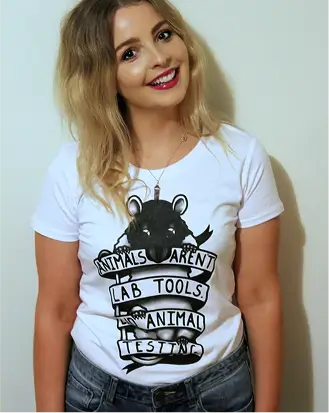Testing products and product ingredients such as chemicals, drugs, household products, pesticides and cosmetics on animals is time-consuming and expensive, and the results are not accurately applicable to humans.
Predicting the potential risks that chemicals and products have to human health or the environment can be done accurately without the use of animals.
EXAMPLES OF HUMAN-BASED RESEARCH METHODS
COMPUTER PROGRAMS AND AI
Sophisticated computer programs can simulate humans - from individual organs to the whole body.
These models can help provide information about chemicals and their effects on human health. Automated decisions trees can be built using knowledge of hundreds of chemicals and predict how likely it is that a new chemical will cause a certain kind of effect.
Many computer models have been developed to predict how toxic something will be to humans.
For example, by developing a large database of known chemicals and mapping the relationships between chemical structures and toxic properties, researchers were able to automatically predict the toxic properties of chemical compounds, more accurately than an animal test could.
Developments in artificial intelligence (AI) are also creating exciting opportunities for human-based testing.
For example, researchers from IBM are developing a new artificial intelligence model for testing novel drugs and other substances rather than using animals!
This AI model was trained using data from about 50,000 molecules. That molecular data was uploaded to the computer-based model, allowing it to recognize the difference between toxic and non-toxic structures.
The researchers involved he model’s analysis is more trustworthy for users than an animal model...because it directly analyzes the molecule’s properties and how those might affect humans. Animal tests, by comparison, are indirect because they look at how an animal reacts to a substance, and then extrapolates that to humans."
HIGH-THROUGHPUT SCREENING
High-throughput screening is a drug discovery process that allows automated testing of large numbers of chemical and compounds for a specific biological target: These usually involve testing chemical activity at the molecular level.
OTHER METHODS INVOLVE USING:
- Ingredients that we already know are safe and that we already have information on.
- Human Tissue Models. Reconstituted human skin models can be used instead of outdated animal tests like the Draize test. For example, EpiSkin and XCellR8 have both developed in vitro human skin and epithelial models. Mat Tek has also created a wide variety of human tissue models.
LEARN MORE
- Read about XCellR8’s many regulatory safety tests that are entirely animal and animal-product free.
- Check out the Database of Validated & Accepted Alternative Methods (and others) for measuring oral toxicity, inhalation toxicity, ecotoxicity carcinogenicity, reproductive and developmental toxicity, eye and skin sensitisation and damage, vaccine potency and more.





